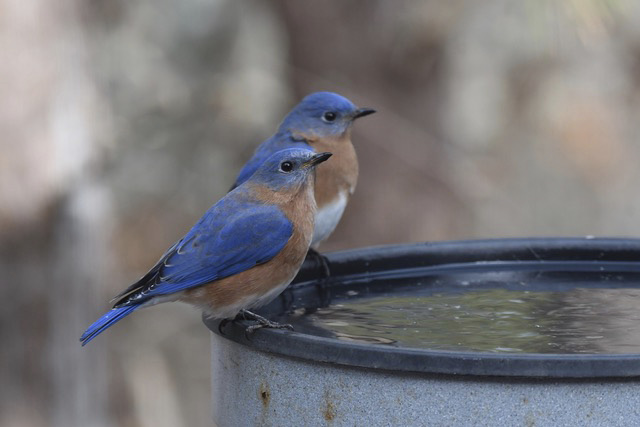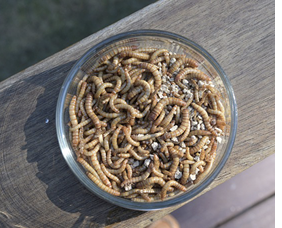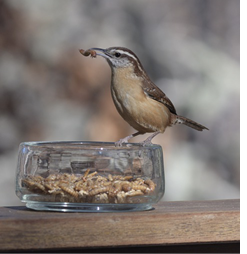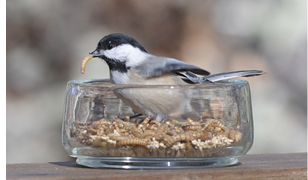David Clapp

Eastern Bluebirds. All photographs by the author.
My wife Fran and I occasionally have had Eastern Bluebirds appear at our feeders. They will drop to the ground to eat suet flakes dislodged by the woodpeckers or feed at the suet cakes that hang like drab flat ornaments throughout the yard. The bluebirds always get me thinking of ways to keep them around the house or at least around the yard, especially ways to secure them for the winter.
For old-time birders and birdfeeding folks, the very idea of bluebirds in the winter is a bit of a shock. They were not commonly found in New England in the winter and the breeding population was modest at best. The Eastern Bluebird has made a leap forward in distribution and population during the recent decade or two, in great part due to people putting up nesting boxes for the bluebirds. There are hundreds of bluebird boxes out there and "bluebird trails" installed, monitored, and maintained by nature groups and bird clubs that offer nesting opportunities galore.
The Mass Audubon Breeding Bird Atlases (Petersen and Meservey 2003) and (Walsh and Petersen 2013) show an increase in Eastern Bluebird breeding presence by topographic block of about 300%; from 174 blocks to 524:
Demonstrating an impressive resiliency and acting as an icon for the conservation movement, the recovery of the Eastern Bluebird represented the product of the hard work of thousands of volunteers across the eastern United States. Increasing from 254 to 713 occupied blocks from Atlas 1 to Atlas 2, their recovery was impressive. Confirmation rates skyrocketed for the species, from 18% to 50% as nest boxes became commonplace on the landscape making the species even more obvious as it went about its housekeeping duties. Examining only the effort-controlled blocks, one of the remarkable features of this species was its stability – it was only lost from 37 blocks where it was found during Atlas 1. The species was widespread across all regions, and occupied more than 40% of each and every region in the state. (Walsh and Petersen 2013)
It matters little that the great majority of these boxes house nesting Tree Swallows or House Wrens. The Tree Swallows, especially, are a nice addition to any landscape.
When we had boxes up for Eastern Bluebirds at the Daniel Webster Wildlife Sanctuary in Marshfield, Massachusetts in the 1980s and 1990s (and currently), it was never a certainty that bluebirds would use them. The two aforementioned species would use them and some years a pair or two of bluebirds would as well. In most years, there would be bluebirds on the property in January, February, March, and April, but they would often disappear during what seemed to be the best time for nesting. In some years they would reappear in July and nest. It seemed as if it was a second nest in a second location, but there was no way to test that idea. We were just happy to have them back.
Bluebirds get a lot of their food by sallying—sitting on a perch and dropping down to catch their prey and flying back up to the perch. The food item is often a beetle, as evidenced by the droppings that sometimes glisten with shiny beetle wings (elytra). Providing bluebirds with beetles is hard to duplicate in a home birdfeeding operation, but I thought that they must like mealworms—doesn't everyone!
We ordered mealworms, thousands of mealworms. We sent for medium and large and a few giants. They arrived quickly and we dropped them into the container where they would live quite happily until they were offered up to the hungry avian world.
The housing required is modest—any plastic or glass container will do. Mealworms don't climb so the container needs to be only a few inches tall. A kitty litter box is large enough for a huge number of mealworms; start smaller. We use a small plastic storage box designed (probably) to pack away sweaters in the summer, but a similar box for a pair of shoes is fine for hundreds and hundreds of mealworms. A plastic bucket works just fine. Remember, they are small and don't need privacy.
The food and bedding are one and the same. We use nonmedicated chick starter or wheat bran, which is only about $5.00 for a bag big enough to last most of the winter. Any bran, wheat, or pulverized cereal or dry dog food will work also. Preparing the housing and food is a one-time task; you pour in the feed and add the worms —done. Keep them cool, however, as they will metamorphose if fed and kept warm. Ours live in the garage at about 45–50 degrees. This keeps their metabolism low and prevents pupation, and they will survive for months at this temperature. The pupa will eventually turn into a small black beetle. If you have a smallish number of mealworms in something like a feta cheese or cottage cheese plastic tub, keep them in the refrigerator if your significant other will allow. They won't wander around.

A bowl of mealworms.
Bring the mealworms into your living space once a week, warm them up, and feed them with carrot, potato, or apple peelings. This gives them a busy day of eating and perhaps molting. We take apple or carrot peelings or a very thin slice of potato every now and then, especially during the warm period, and lay it on the surface of the feed. The worms will wiggle their way in and under the slice where they gain access to a bit of new food and moisture. Don't keep anything too wet in the container because there is always the chance of mold developing, as with cheese left too long in a refrigerator. But do warm and feed your mealworms every now and then.
If you have some burlap or other coarsely and loosely woven fiber, you can cut it into small pieces and layer them in the worm container. The mealworms will crawl in between the sheets, allowing you to collect them without getting a handful of chicken food at the same time. It is also easy enough to scoop out a dish mixed with chicken starter and put it outside. Birds know how to scratch through stuff to get at the food and they will soon learn that it is well worth digging through your offering.
We (well, Fran doesn't deal with the worms very often actually) put the worms on the deck rail in a small clear dish early each morning. The dish is a bit larger than something you would serve crème brûlée in. The mealworms don't climb so the sides of the feeding dish need to be only an inch or so high. A cereal bowl would probably work just fine. If they were on a dinner plate they would eventually crawl off, especially if you feed into warm weather. They are much less active in the cold (aren't we all).
The birds get used to this special food and often arrive immediately after it is placed on the deck. We like to watch the feeding activities so our dish is placed about eight feet from the dining room table in front of a double-door glass slider. The worms will not last all day because the birds seem to eat and eat and eat.
The list of local feeder birds that take the mealworms is probably predictable but their behavior is interesting and not always predictable.
American Robins are not numerous in our yard, but there is usually one big bully robin that tries to dominate the feeders even though it has little interest in most of the seed and suet we offer. The robin does like mealworms, however, and is often the first arrival. Its mere presence intimidates many other species. We counted the worms taken by our robin and the low number for one binge was 15 and the high was 27. We let it eat its fill each time.

Carolina Wren.
The only birds not intimidated by the robin are the pair of Carolina Wrens that boldly land on the dish and take worms from right under the robin. The Carolina Wrens are often in pairs. Their population is recovering from a deadly cold and snowy winter a few years ago; it is nice to have these busy and inquisitive birds back in the yard.
Tufted Titmice are the busiest of the worm-birds. They take them one at a time and fly off to devour them privately. But they return quickly and frequently. It is hard to count the specific activities of one titmouse because they seem to come in waves one after the other for a spell of time before the group disappears for the day. Black-capped Chickadees and White-breasted Nuthatches feed in the same manner but with less energy and seemingly much less frequency.
The mealworm is a nice addition to a feeding station and nowhere near as creepy as you might first think. Aside from being quiet, aroma-free, and inexpensive, they make for a very entertaining adjunct to your local bird life.

Black-capped Chickadee.
Online, you can find mealworm farms and many dealers who grow and sell mealworms. They can be shipped in various sizes and quantities. We ordered 7000 large mealworms from a company in California (Rainbow Mealworm*) and they arrived on the third day. Pretty good.
It is easy to underestimate what your birds will eat. A handful of worms grabbed from the housing box may total less than 100. Don't be stingy with your offerings. It always surprises me to see how many mealworms remain after I think we have been depleting the stock.
By the way, the Eastern Bluebirds that started our mealworm habit never returned.
* Rainbow Mealworms grows and sells many insect food items in addition to mealworms. They offer butterworms, crickets, Dubia and red runner and Madagascar roaches, flightless fruit flies, giant mealworms, hornworms, isopods, mantis, Mexican jumping beans, phoenix worms, earthworms, rice flour beetles, silkworms, springtails, vinegaroons (whip scorpions—an arachnid), waxworms (wax moth larvae), and more. Many of these creatures are bred for reptile owners to use to feed their frogs, toads, and lizards.
References
- Petersen, W. R. and W. R. Meservey, eds. 2003. Massachusetts Breeding Bird Atlas. Lincoln, Massachusetts: Massachusetts Audubon Society.
- Walsh, J. M. and W. R. Petersen, eds. 2013. Massachusetts Breeding Bird Atlas 2. Lincoln, Massachusetts: Massachusetts Audubon Society (Published by Scott and Nix).
David Clapp has had two overlapping careers, one of 35 years with Mass Audubon as a sanctuary director, mostly on the South Shore, and a second as a tour leader, primarily for the Smithsonian Institution's travel program. He currently works with the famous Tanzanian guide Joseph Ndunguru to operate a small-group safari company operating mostly in Tanzania.